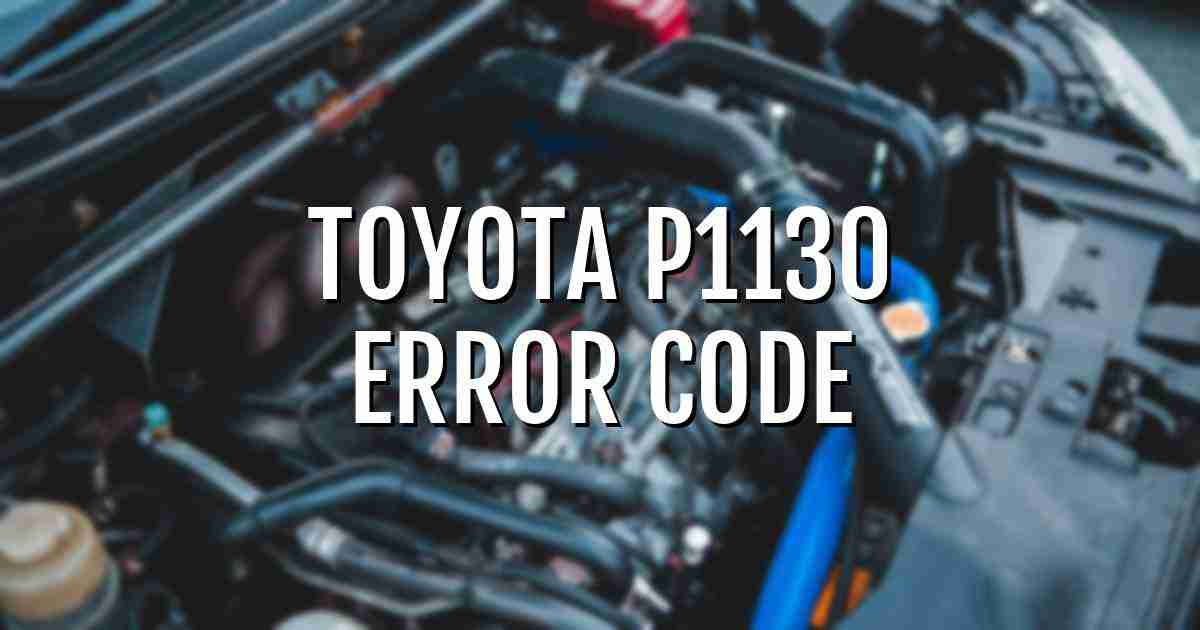The OBD code P1130 for Toyota indicates an issue with the Air Fuel Ratio (A/F) Bank 1 Sensor 1. Symptoms include the Engine Light being ON.
Causes may include a faulty sensor, wiring harness issues, fuel pressure problems, or intake air leaks.
This is a moderate issue that should be addressed promptly.
A possible fix involves inspecting and repairing any damaged components or wiring connections related to the sensor.
| Repair Importance Level | 10.0 (Out of 10) |
| Estimated Repair Time | Approximately 1.0 hour |
| Repair Difficulty Level | 6.67 (Out of 10) |
Symptoms of the Toyota p1130 OBD Code
The vehicle may experience a lack of power or poor fuel economy with fault code P1130.
- Symptoms: Engine Light ON.
- Lack of power during acceleration.
- Rough idle.
- Hesitation when accelerating.
Causes of the Toyota p1130 OBD Code
Possible triggers for Toyota P1130 include vacuum leaks, faulty airfuel ratio sensor, or intake manifold issues.
Do you know you can clear most fault codes—but some could mean serious danger? Don’t take chances with your safety or your family’s safety. This budget-friendly car scanner makes it easy to clear fault codes in seconds while showing you exactly what’s wrong. Plug it in, connect to your Android or iOS phone, and instantly check live data. You’ll know if it’s a minor issue you can clear or something serious that needs attention—so you can drive safely and stress-free. (Today’s Deal)
- P1130 can be caused by a faulty Air fuel Ratio (A/F) Bank 1 Sensor 1.
- An open or shorted Air fuel Ratio (A/F) Bank 1 Sensor 1 harness.
- A poor electrical connection in the Air fuel Ratio (A/F) Bank 1 Sensor 1 circuit.
- Low fuel pressure.
- Malfunctioning fuel injector.
- Intake air leaks.
Fixing Toyota Error Code p1130 Step By Step
Address the issue by inspecting the intake air control valve and related wiring for faults.
- To fix Toyota OBDII code P1130, first, review the ‘Possible Causes’ mentioned above and visually examine the corresponding wiring harness and connectors.
- Ensure to check for any damaged components and inspect the connector pins for signs of being broken, bent, pushed out, or corroded.
- Next, check the operation of the AirFuel Ratio Sensor and replace it if necessary.
- Clear the fault codes from the vehicle’s computer using a scan tool.
- Finally, test drive the vehicle to verify that the code does not return, indicating a successful repair.
Cost Of Fixing Toyota p1130 Fault Code
Diagnosing and repairing fault code P1130 on a Toyota typically involves addressing issues with the A/F sensor.
The cost to diagnose and fix a Toyota OBD code P1130 typically ranges from $75 to $150, based on an estimated repair time of 1. 0 hour.
Factors like shop rates and the complexity of the issue can influence the final cost.
That fault code is a turning point. If repair costs are climbing and your current loan feels like it’s holding you back, this is the time to plan ahead. The free Car Loan Payment Tracker helps you see how quickly you can pay off what’s left—and start preparing, with confidence, for your dream car.
Details of the Toyota p1130 OBD Code
Toyota fault code P1130 relates to an issue with the Air/Fuel Ratio Sensor Circuit Range/Performance.
Code P1130 for Toyota vehicles indicates an issue with the Air/Fuel Ratio Sensor Circuit Range/Performance.
This code is triggered by the Engine Control Module (ECM) when it detects that the signal from the Air/Fuel Ratio Sensor is out of the expected range or not performing within specified parameters.
The Air/Fuel Ratio Sensor is responsible for monitoring the oxygen content in the exhaust gases and providing feedback to the ECM to adjust the air/fuel mixture for optimal combustion.
Mechanic’s Tech Notes
Detailed information on diagnosing and repairing fault code P1130 in Toyota vehicles.
To diagnose and fix OBDII code P1130 on a Toyota, start by visually inspecting the wiring harness and connectors related to the A/F sensor circuit.
Look for any damage or corrosion.
Use a multimeter to check the voltage at the A/F sensor connector.
Ensure the sensor is receiving proper voltage and ground.
Scan tools can help monitor sensor data and confirm proper operation.
If the sensor readings are out of range, consider replacing the A/F sensor.
Additionally, check for any exhaust leaks that could affect sensor readings.
Clear the code after repairs and recheck for any recurring issues.
FAQ
Common symptoms of OBD code P1130 in a Toyota: Engine Light ON, rough idle, poor fuel economy. Causes: Faulty A/F Sensor Bank 1 Sensor 1, wiring issues. Fix: Inspect and repair wiring/connectors.
The typical root cause of OBD code P1130 in a Toyota is a faulty Air Fuel Ratio (A/F) Bank 1 Sensor 1 or related wiring issues.
Diagnose and repair OBD code P1130 in a Toyota by checking A/F Bank 1 Sensor 1, its harness, wiring, fuel system, and intake for faults.

Wrap Up
If your Toyota triggers OBDII code P1130 with symptoms like rough idle, poor acceleration, or decreased fuel efficiency, it may indicate a faulty A/F sensor or wiring issue in the airfuel ratio circuit.
This code typically points to a problem with the A/F sensor bank 1 sensor 1 in the exhaust system.
To address Toyota OBDII code P1130, start by inspecting the A/F sensor bank 1 sensor 1 and its wiring harness for any signs of damage or corrosion.
Test the sensor’s resistance and voltage output to determine if it needs replacement.
Additionally

